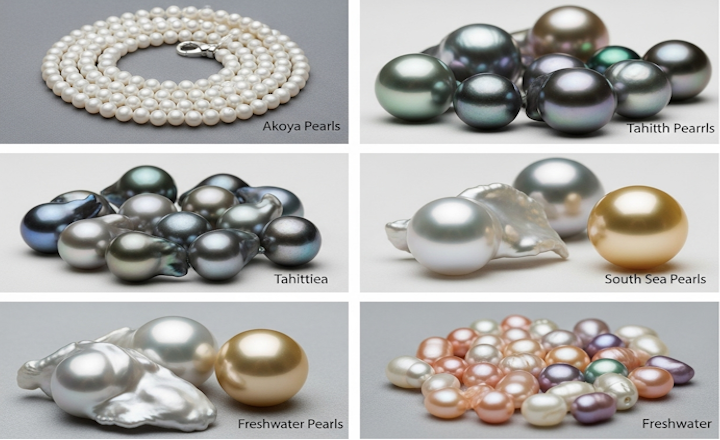
Pearls have long held a special place in jewellery—synonymous with elegance, purity and timeless beauty. But not all pearls are created equal. If you’re just beginning your journey into the world of pearls, it helps to understand the major types, their characteristics, and how to choose wisely. Whether you’re shopping for a classic strand or a standout statement piece, this guide will walk you through the essentials.
In fact, for those exploring higher-end options down under, Allure South Sea Pearls offers an excellent reference point for quality South Sea jewels right here in Australia.
What Makes a Pearl a Pearl?
Before diving into types, it’s worth noting that almost all pearls on the market today are cultured rather than entirely natural. A cultured pearl forms when a technician places a bead or piece of mantle tissue inside an oyster or mussel, which then deposits layers of nacre (the lustrous material) over time.
Pearls are generally classified by:
- Type of mollusc (oyster, mussel, etc.)
- Environment (saltwater or freshwater)
- Size, shape, colour, lustre, surface quality, nacre thickness and matching (especially when making strands)
Akoya Pearls
Origin & Growing Conditions
Akoya pearls come from small saltwater oysters, especially the Pinctada fucata species. They were among the first pearls to be widely cultured, largely pioneered in Japan. Because the oysters are relatively small, Akoya pearls tend not to grow very large—but they are prized for their high lustre and classic appeal.
Characteristics & Appeal
- Size: Typically from about 3 mm up to 9.5 mm; the sweet spot for necklaces is often 6–9 mm.
- Colour & overtones: Most often white or cream, sometimes with rose, silver or soft pink overtones.
- Lustre: Sharp, mirror-like lustre is a hallmark.
- Shape: Akoyas are often very round.
- Surface & nacre: Surface blemishes may be more evident, and nacre thickness is important.
Best Uses & Considerations
Akoya pearls make for wonderful classic strands, stud earrings, and occasionally rings. They’re often more accessible price-wise than larger saltwater pearls, making them a popular entry point into fine pearls.
Tahitian Pearls
Origin & Cultivation
Tahitian pearls come primarily from the black-lip oyster (Pinctada margaritifera), cultivated around French Polynesia. The oysters are larger, and the culturing process often takes 2+ years.
Distinctive Characteristics
- Colour: Tahitian pearls are often known as “black pearls,” but they range in shades of dark grey, peacock green, bluish, silvery, and more.
- Size: Typically in the 8–15 mm range (sometimes larger).
- Lustre: More subtle or satiny compared to Akoya’s mirror shine.
- Shapes & surface: Round Tahitian pearls are rarer; many will be semi-round, drop, button or baroque.
Appeal & Uses
Because of their dramatic, dark tones and exotic appeal, Tahitian pearls are often used in statement necklaces, pendants, and earrings that play on contrast.
South Sea Pearls
Origin & Cultivation
South Sea pearls are produced by the giant Pinctada maxima oyster, farmed in Australia, Indonesia, the Philippines and surrounding waters. Nucleation takes place when the oyster is mature, and the pearl may take 2–4 years to develop.
Characteristics & Appeal
- Size: Among the largest cultured pearls—commonly 9–14 mm, and sometimes up to 20 mm or more.
- Colour & variety: White/silver-lipped South Seas show whites and silvers, while golden-lipped oysters produce pearls from pale yellow to deep gold.
- Lustre & nacre: Thick nacre (2–4 mm or more) and a rich, satiny lustre.
- Shape & surface: Perfectly round South Sea pearls are rare; many are baroque or drop-shaped.
Why They’re Coveted
South Sea pearls represent a luxury category. They command premium pricing due to their size, nacre thickness, and limited yield. Australian South Sea pearls are particularly renowned for their exceptional quality.
Freshwater Pearls
Origin & Cultivation
Freshwater pearls are cultivated in mussels—typically in lakes, rivers or dams, with much of the cultivation centred in China. Many freshwater pearls are mantle-tissue nucleated rather than bead-nucleated, allowing more pearls per harvest.
Characteristics & Appeal
- Size: Ranges from a few mm up to 12–15 mm (in some modern varieties).
- Colour & overtones: Available in many hues—white, cream, pink, lavender, peach, and more.
- Lustre: Generally softer, though high-quality freshwater pearls have improved.
- Shape: Many are non-round or baroque, though near-rounds are now common.
Strengths & Limitations
Freshwater pearls are more affordable, making them ideal for everyday wear, layering, and creative jewellery designs. However, they generally lack the scale and prestige of saltwater varieties.
Care Tips for Pearls (All Types)
- Put them on last (after makeup/perfume).
- Wipe gently after wearing.
- Store separately in soft pouches.
- Avoid harsh chemicals and heat.
- Restring strands every few years.
- Don’t store in airtight containers.
Which style suits you best?
If you’re starting your pearl journey, Akoya and high-quality freshwater pearls offer accessible and elegant entry points. If your tastes lean toward dramatic, exotic tones, Tahitian pearls add depth and character. For scale, luminosity and luxury, South Sea pearls are in a league of their own. Whichever path you choose, understand what you’re buying, trust your eye for glow, and wear your pearls often—they thrive in the warmth of being loved.
| < Prev | Next > |
|---|







